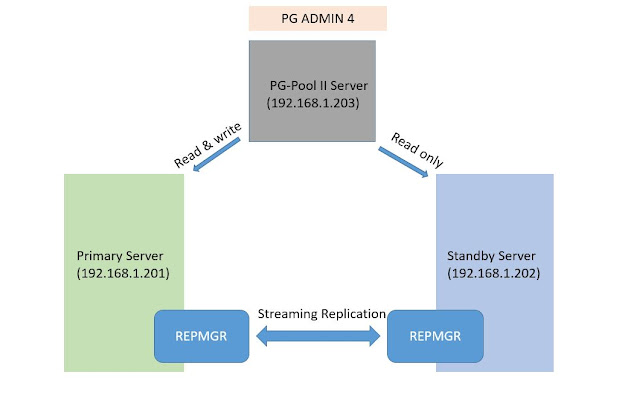PostgreSQL Schema Management
POSTGRESQL SCHEMA:
A schema is a named collection of tables. A schema can also contain views, indexes, sequences, data types, operators, and functions.
There are several reasons why one might want to use schemas:
- To allow many users to use one database without interfering with each other.
- To organize database objects into logical groups to make them more manageable.
- Third-party applications can be put into separate schemas so they do not collide with the names of other objects.
Default Schema:
public
Examples:
Current schema list of table:
pearl=# \dt+
List of relations
Schema | Name | Type | Owner | Size | Description
--------+-------+-------+----------+-------+-------------
public | muthu | table | postgres | 16 kB |
(1 row)
Current database list of schemas:
pearl=# \dn+
List of schemas
Name | Owner | Access privileges | Description
--------+----------+----------------------+------------------------
public | postgres | postgres=UC/postgres+| standard public schema
| | =UC/postgres |
(1 row)
pearl=# select * from pg_namespace ;
nspname | nspowner | nspacl
--------------------+----------+-------------------------------------
pg_toast | 10 |
pg_temp_1 | 10 |
pg_toast_temp_1 | 10 |
pg_catalog | 10 | {postgres=UC/postgres,=U/postgres}
public | 10 | {postgres=UC/postgres,=UC/postgres}
information_schema | 10 | {postgres=UC/postgres,=U/postgres}
(6 rows)
Find current schema:
pearl=# show search_path ;
search_path
-----------------
"$user", public
(1 row)
How to create schema:
pearl=# create schema s1;
CREATE SCHEMA
how to change schema:
pearl=# set search_path TO s1;
SET
pearl=# create table siva(id int,name text);
CREATE TABLE
pearl=# \dt+
List of relations
Schema | Name | Type | Owner | Size | Description
--------+------+-------+----------+------------+-------------
s1 | siva | table | postgres | 8192 bytes |
(1 row)
How to set Default schema:
pearl=# set search_path TO DEFAULT ;
SET
pearl=# show search_path ;
search_path
-----------------
"$user", public
(1 row)
pearl=# \dt+
List of relations
Schema | Name | Type | Owner | Size | Description
--------+-------+-------+----------+-------+-------------
public | muthu | table | postgres | 16 kB |
(1 row)
How to create table on particular schema:
pearl=# create table s1.mms(id int,name text);
CREATE TABLE
pearl=# \dt+
List of relations
Schema | Name | Type | Owner | Size | Description
--------+-------+-------+----------+-------+-------------
public | muthu | table | postgres | 16 kB |
(1 row)
List of particular schema tables:
pearl=# \dt s1.*
List of relations
Schema | Name | Type | Owner
--------+------+-------+----------
s1 | mms | table | postgres
s1 | siva | table | postgres
(2 rows)
pearl=# \dt public.*
List of relations
Schema | Name | Type | Owner
--------+-------+-------+----------
public | muthu | table | postgres
(1 row)
Move table for one schema to another schema:
pearl=# alter table s1.mms set schema public ;
ALTER TABLE
pearl=# \dt public.*
List of relations
Schema | Name | Type | Owner
--------+-------+-------+----------
public | mms | table | postgres
public | muthu | table | postgres
(2 rows)
How to change Schema name:
pearl=# alter schema s1 rename to s2;
ALTER SCHEMA
pearl=# \dn+
List of schemas
Name | Owner | Access privileges | Description
--------+----------+----------------------+------------------------
public | postgres | postgres=UC/postgres+| standard public schema
| | =UC/postgres |
s2 | postgres | |
(2 rows)
How to change schema owner:
pearl=# alter schema s2 owner to u1;
ALTER SCHEMA
pearl=# \dn+
List of schemas
Name | Owner | Access privileges | Description
--------+----------+----------------------+------------------------
public | postgres | postgres=UC/postgres+| standard public schema
| | =UC/postgres |
s2 | u1 | |
(2 rows)
How to drop schema:
pearl=# drop schema s2;
ERROR: cannot drop schema s2 because other objects depend on it
DETAIL: table s2.siva depends on schema s2
HINT: Use DROP ... CASCADE to drop the dependent objects too.
Any objects depending on schema to drop:
pearl=# drop schema s2 cascade;
NOTICE: drop cascades to table s2.siva
DROP SCHEMA
pearl=# \dn+
List of schemas
Name | Owner | Access privileges | Description
--------+----------+----------------------+------------------------
public | postgres | postgres=UC/postgres+| standard public schema
| | =UC/postgres |
(1 row)



Excellent article and this helps to enhance your knowledge regarding new things. Waiting for more updates.
ReplyDeleteVariable Scope PHP
PHP Global Variable